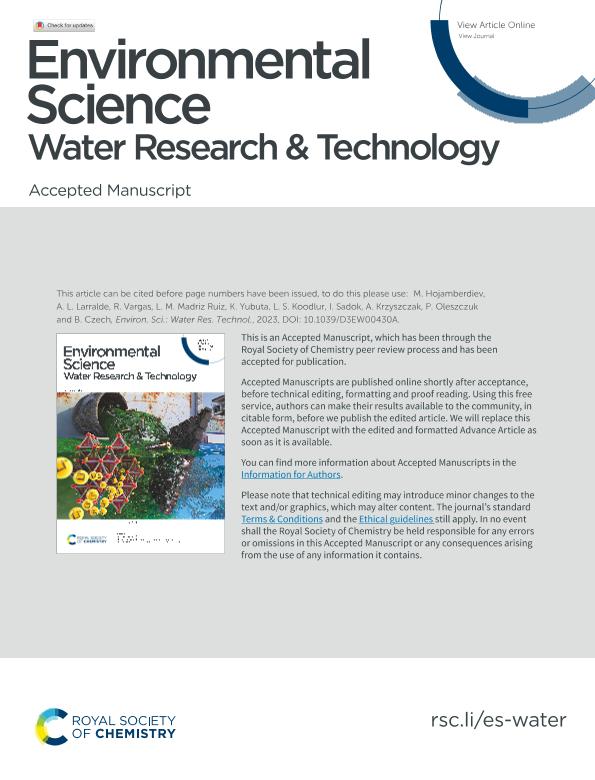Artículo
Unlocking the effect of Zn2+ on crystal structure, optical properties, and photocatalytic degradation of perfluoroalkyl substances (PFAS) of Bi2WO6
Hojamberdiev, Mirabbos; Larralde, Ana Laura ; Vargas Balda, Ronald Eduardo
; Vargas Balda, Ronald Eduardo ; Madriz Ruiz, Lorean Mercedes
; Madriz Ruiz, Lorean Mercedes ; Yubuta, Kunio; Sannegowda, Lokesh Koodlur; Sadok, Ilona; Krzyszczak Turczyn, Agnieszka; Oleszczuk, Patryk; Czech, Bożena
; Yubuta, Kunio; Sannegowda, Lokesh Koodlur; Sadok, Ilona; Krzyszczak Turczyn, Agnieszka; Oleszczuk, Patryk; Czech, Bożena
 ; Vargas Balda, Ronald Eduardo
; Vargas Balda, Ronald Eduardo ; Madriz Ruiz, Lorean Mercedes
; Madriz Ruiz, Lorean Mercedes ; Yubuta, Kunio; Sannegowda, Lokesh Koodlur; Sadok, Ilona; Krzyszczak Turczyn, Agnieszka; Oleszczuk, Patryk; Czech, Bożena
; Yubuta, Kunio; Sannegowda, Lokesh Koodlur; Sadok, Ilona; Krzyszczak Turczyn, Agnieszka; Oleszczuk, Patryk; Czech, Bożena
Fecha de publicación:
09/2023
Editorial:
Royal Society of Chemistry
Revista:
Environmental Science: Water Research and Technology
ISSN:
2053-1400
e-ISSN:
2053-1419
Idioma:
Inglés
Tipo de recurso:
Artículo publicado
Clasificación temática:
Resumen
Bismuth tungstate (Bi2WO6) with a layered structure and visible light response exhibits excellent photocatalytic activity. To enhance its photocatalytic activity for the degradation of perfluoroalkyl substances (PFAS), Zn2+ is partially substituted for Bi3+ in the Bi2WO6 lattice in this study. Particularly, the effect of Zn2+ content (0-22.5 at%) on the crystal structure, optical property, and photocatalytic activity for the photodegradation of PFAS of Bi2WO6 is investigated. According to the Le Bail fits, the unit-cell volume is slightly reduced from 487.7 Å3 to 480.8 Å3 by the partial substitution of smaller Zn2+ (0.74 Å for CN = 6) for larger Bi3+ (1.03 Å for CN = 6) in the Bi2WO6 crystal lattice, and the solubility of Zn2+ in the Bi2WO6 lattice is found to be below 17.5 at%. The partial substitution of Zn2+ influences the self-aggregation of nanoparticles, Ostwald ripening, and self-organization of nanoplates, resulting in different morphologies. Although the optical bandgap energy of Bi2WO6 is not significantly altered upon the partial substitution of Zn2+, the conduction and valence bands simultaneously shift upward. Among the Bi2−xZnxWO6+δ photocatalysts, 2.5 at% Zn2+-substituted Bi2WO6 exhibits larger water oxidation photocurrent density (0.316 mA cm−2 at 1.23 VRHE) and the highest photocatalytic activity for the photodegradation of PFHxA (k1 = 0.012 min−1). The trapping experiments confirm that the photo-excited holes (h+) and superoxide radicals (O2˙−) are the major reactive species involved in the photodegradation of PFHxA. Liquid chromatography quadrupole time-of-flight mass spectrometry (LC-QTOF/MS) reveals that decarboxylation and defluorination are the main possible routes for the photodegradation of PFHxA over Bi2−xZnxWO6+δ photocatalysts. Our findings suggest that the partial Zn2+-to-Bi2+ substitution can enhance the photocatalytic activity of Bi2WO6 for the degradation of PFAS.
Palabras clave:
BI2WO6
,
PFAS
,
ZINC
,
WATER PURIFICATION
,
PHOTOCALAYSIS
,
CRYSTAL STRUCTURE
Archivos asociados
Licencia
Identificadores
Colecciones
Articulos(IIB-INTECH)
Articulos de INST.DE INVEST.BIOTECNOLOGICAS - INSTITUTO TECNOLOGICO CHASCOMUS
Articulos de INST.DE INVEST.BIOTECNOLOGICAS - INSTITUTO TECNOLOGICO CHASCOMUS
Articulos(SEDE CENTRAL)
Articulos de SEDE CENTRAL
Articulos de SEDE CENTRAL
Citación
Hojamberdiev, Mirabbos; Larralde, Ana Laura; Vargas Balda, Ronald Eduardo; Madriz Ruiz, Lorean Mercedes; Yubuta, Kunio; et al.; Unlocking the effect of Zn2+ on crystal structure, optical properties, and photocatalytic degradation of perfluoroalkyl substances (PFAS) of Bi2WO6; Royal Society of Chemistry; Environmental Science: Water Research and Technology; 9; 11; 9-2023; 2866-2879
Compartir
Altmétricas



